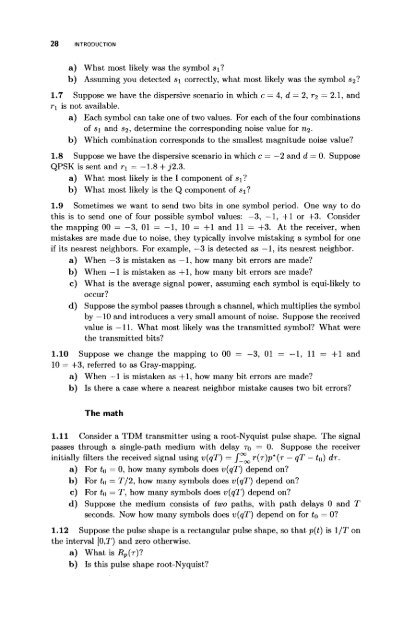mohatta2015.pdf
signal processing from power amplifier operation control point of view
signal processing from power amplifier operation control point of view
You also want an ePaper? Increase the reach of your titles
YUMPU automatically turns print PDFs into web optimized ePapers that Google loves.
28 INTRODUCTION<br />
a) What most likely was the symbol si?<br />
b) Assuming you detected s\ correctly, what most likely was the symbol S2?<br />
1.7 Suppose we have the dispersive scenario in which c = 4, d = 2, Γ2 = 2.1, and<br />
ri is not available.<br />
a) Each symbol can take one of two values. For each of the four combinations<br />
of s 1 and S2, determine the corresponding noise value for n-¿.<br />
b) Which combination corresponds to thé smallest magnitude noise value?<br />
1.8 Suppose we have the dispersive scenario in which c = —2 and d = 0. Suppose<br />
QPSK is sent and r x = -1.8 + j'2.3.<br />
a) What most likely is the I component of si ?<br />
b) What most likely is the Q component of si?<br />
1.9 Sometimes we want to send two bits in one symbol period. One way to do<br />
this is to send one of four possible symbol values: —3, —1, +1 or +3. Consider<br />
the mapping 00 = —3, 01 = —1, 10 = +1 and 11 = +3. At the receiver, when<br />
mistakes are made due to noise, they typically involve mistaking a symbol for one<br />
if its nearest neighbors. For example, —3 is detected as —1, its nearest neighbor.<br />
a) When —3 is mistaken as —1, how many bit errors are made?<br />
b) When —1 is mistaken as +1, how many bit errors are made?<br />
c) What is the average signal power, assuming each symbol is equi-likely to<br />
occur?<br />
d) Suppose the symbol passes through a channel, which multiplies the symbol<br />
by —10 and introduces a very small amount of noise. Suppose the received<br />
value is —11. What most likely was the transmitted symbol? What were<br />
the transmitted bits?<br />
1.10 Suppose we change the mapping to 00 = —3, 01 = — 1, 11 = +1 and<br />
10 = +3, referred to as Gray-mapping.<br />
a) When —1 is mistaken as +1, how many bit errors are made?<br />
b) Is there a case where a nearest neighbor mistake causes two bit errors?<br />
The math<br />
1.11 Consider a TDM transmitter using a root-Nyquist pulse shape. The signal<br />
passes through a single-path medium with delay τ 0 = 0. Suppose the receiver<br />
initially filters the received signal using v(qT) = f τ{τ)ρ*(τ — qT — to) dr.<br />
a) For ¿o = 0, how many symbols does v(qT) depend on?<br />
b) For to = T/2, how many symbols does v(qT) depend on?<br />
c) For to = T, how many symbols does v{qT) depend on?<br />
d) Suppose the medium consists of two paths, with path delays 0 and T<br />
seconds. Now how many symbols does v(qT) depend on for i 0 = 0?<br />
1.12 Suppose the pulse shape is a rectangular pulse shape, so that p(t) is \/T on<br />
the interval [0,7') and zero otherwise.<br />
a) What is ñ p (r)?<br />
b) Is this pulse shape root-Nyquist?



